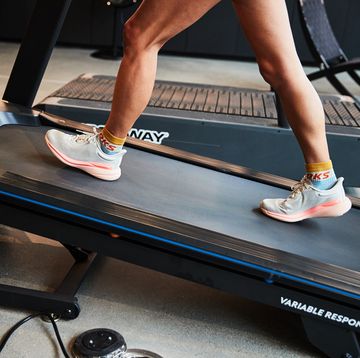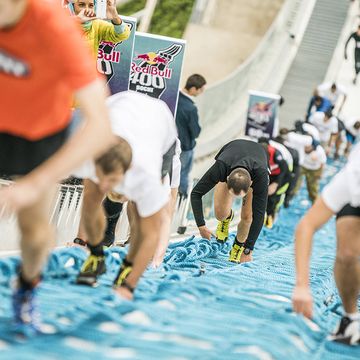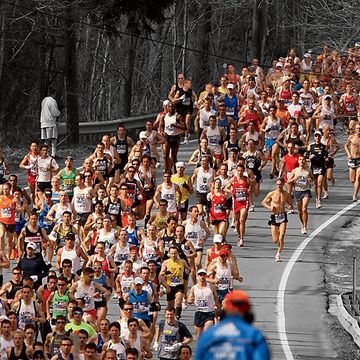Learning how to run hills—and run them well—is an important skill for all runners. They help you get fitter, faster and they build serious strength in your hips, legs, and core.
The reason hills are so good for you is the same reason athletes love to hate them: They’re hard. Sometimes really hard.
“I hate running hills myself,” says Janet Hamilton, certified strength and conditioning specialist, exercise physiologist, and running coach with Running Strong. Hamilton believes most runners loathe hills because, quite simply, they’re doing them wrong.
With the right tips and know-how, though, any athlete can improve their hill running abilities—and maybe even learn to enjoy them in the process. Here’s what you need to know about how to run hills.
The benefits of running hills
Hill-specific training is “super beneficial,” says Hamilton. For one, it can help build strength in your core and lower body. That’s because compared to running on flat ground, running up an incline requires you to exert more force to resist the pull of gravity.
To exert that force, your muscles—especially your hips, core, and legs—have to work harder. “It’s like resistance training,” says Nicole Sifuentes, certified strength and conditioning specialist, two-time Olympian, and running coach with Sifuentes Coaching.
Moreover, when your muscles work harder, your heart and lungs also work harder to supply your body with the oxygen it needs to fuel for your muscles, explains Hamilton. That makes hill training a great cardio challenge, too.
“Even if you run ‘easy’ up a hill, it gets your heart pumping faster than if you’re just on flat ground,” says Sifuentes.
In addition, hill training forces the body into a different range of motion that can be beneficial for improving your mobility. As Sifuentes explains it, to move up a hill, you have to pick your knees up higher and have greater hip extension than you do when striding on flat ground. That greater range of motion leads to greater mobility, she says. Additionally, when you return to flat terrain, your stride may feel smoother and easier because your body isn’t having to force itself through the same extreme range of motion, she explains.
On top of that, when running hills, it can be easier to understand—and put into practice—good running form. “When you’re running, generally the thought should be that you are pushing yourself forward when you run,” explains Sifuentes. “You don’t want [your foot] to land way out in front of your body; you want it to land underneath your body so that you can put force into the ground and push yourself forward.” On hills, it’s a little easier to internalize that concept, says Sifuentes, who encourages runners to think about “pushing” themselves uphill, not pulling.
Research supports the notion that hills are worth your while: A study of 32 athletes published in 2017 concluded that 12 weeks of hill training can significantly boost VO2 max, resting heart rate, speed endurance, and race performance for middle- and long-distance athletes. Another study, from 2009, found that the 54 runners who trained on sloping terrain for eight weeks saw greater improvements in their maximum running speed during a 35-meter sprint test, compared to runners who trained on flat ground.
The caveat to all this is that runners with Achilles problems and knee issues that hurt going downhill should get treatment for their ailments and avoid hill training until their issues resolve, says Sifuentes. That’s because powering up an incline can place a lot of strain on the calves, and tackling a descent can exacerbate certain knee problems.
How to run and race uphill
A lot of runners like to “attack” hills, or try to hold the same pace up an incline that they were maintaining on level ground, says Hamilton. While that tenacity is commendable, these athletes often arrive at the top of hill extremely winded. Then, they’ll try to recover on the downhill and subconsciously pump the brakes on their speed, which will then burn up more energy in their quads as a result. “It’s just not the most productive way to do hills,” Hamilton explains.
A better strategy for hill racing, say Hamilton and Sifuentes, is to focus on maintaining a consistent effort uphill.
Here’s how that works and how you can practice it in a workout: As you run on level ground, get a sense of how hard you’re working at that given pace, says Hamilton. Notice what your breathing is like and your rate of perceived exertion; you can also check your heart rate, if you’re wearing a device that tracks it. Then, as you begin climbing a hill, try to keep your effort at the same level. You’ll likely need to slow down to make that happen.
If the hill is super steep, you may even need to walk, and that’s okay. The upside is that you’ll reach the top of the climb no more taxed than you were at the bottom, and as a result, you can “take advantage of the free gift of gravity on the downhill side,” says Hamilton.
“With this even-effort approach, you may be a tad slower on the uphill but you won’t fry your energy reserves and you’ll likely make up any ‘lost’ time on the downhill stretches,” she explains.
Now, once you’ve gotten comfortable with this effort-based approach on a variety of hills—long, short, shallow, steep—you can start experimenting with pace, says Hamilton. For example, perhaps you try holding your speed on a short, shallow hill and see how that impacts your effort level. Once you gain confidence in holding your pace up hills, you can alternate between an “even-effort” and “even-pace” approach on hills, says Hamilton.
Eventually, advanced athletes may try what Hamilton calls a “surge-effort” approach to hills: Basically, you focus on getting to the top of the hill as quickly as possible without allowing yourself to slow once you reach the top. That means you need to hold a speed and effort that you can maintain through and after the ascent. “This keeps people from totally sprinting up a hill only to crash at the top and need to recover,” explains Hamilton, who recommends runners typically only use this strategy in racing toward the very end.
All that said, for most non-elite runners, the best race-day strategy is to hold the same effort on hills, says Hamilton.
Now, in a workout, you can definitely use the surge-effort approach to hills as a way to get in high-intensity training (so long as you’ve mastered the even-effort and even-pace strategies first), says Hamilton. This might involve doing fast hill repeats where you run up the same incline for a set number of reps at a speedy clip.
Just keep in mind hill repeats aren’t meant to be performed at an all-out pace. “You don’t want to start the first hill at max effort because you’re going to have a difficult time running a good entire workout,” says Sifuentes.
In terms of proper form, there aren’t any cues specific to uphill running, says Sifuentes—simply follow the same guidance as you would on flat ground. Avoid reaching forward and “pawing at the ground,” says Sifuentes. “All that’s going to lead you to is overstriding.” Instead, focus on landing with your foot directly below your body. Push off the ground using your glutes, and push the ground away behind you.
If your goal is to go fast up a hill, think quick steps and fully extend your hips, knees, and ankles, Sifuentes adds.
How to get better at running uphill
Want to improve your hill running abilities? Then run more hills. “It sounds very simple, but you will get better if you do them more often,” says Sifuentes.
To get more specific, Hamilton recommends that runners who are new to hills (or returning to them after a long hiatus or injury) start by finding an incline that takes roughly 30 to 90 seconds to run up at an easy effort. Then, climb that hill and focus on arriving at the top no more winded than you were at the bottom, following the even-effort approach. After climbing the hill, run on level ground for 30 seconds, then turn around, descend the hill, and repeat three or four times total. Do this mini workout once a week for two weeks in a row. If your body tolerated it okay (meaning, you don’t have any lingering pains or strains), you can increase the intensity, says Hamilton.
Now, how you increase the intensity of your hill training is up to you and depends a lot on your goals. You could, for example, raise the bar by simply tackling more challenging hills—perhaps ones that are longer, steeper, or both. You could progress to the even-pace approach, where you hold your speed as you climb while paying attention to how that impacts your effort level.
Or, if you’re comfortable with both the even-effort and even-pace approach, you could then incorporate the surge-effort strategy by sprinkling fast hill repeats into your workouts. Just make sure that you’re giving your body enough time to rest in between high-intensity sessions—hill sprints are not something you would likely want to do every single week, says Sifuentes.
Additionally, if you’re prepping for a race, you may decide to incorporate race pace training on a hilly course so you can practice holding the same race pace effort as you tackle an incline, says Hamilton. When training specifically for a race with hills, “think about what your event profile looks like,” says Hamilton. “If you can include hills that resemble the ones you’ll see on race day, that’s ideal.”
Outside of actually running, you can also build your hill climbing abilities in the gym. Doing functional, lower-body exercises—like squats and lunges, or even just taking the stairs—can strengthen the muscles that help you power up an incline, says Hamilton. As a general rule of thumb, Hamilton encourages runners to do flexibility exercises daily and strength work two to three times a week.
Don’t forget about running downhill
Hill training isn’t just about going up—what you do on the downhill matters, too. If you don’t practice for it, downhill running can “wreck your legs,” due to how hard your muscles have to work to brake, says Sifuentes. That’s why you should balance uphill training with downhill running, too.
For effective downhill running, Hamilton encourages athletes to accept the “gift of gravity,” “go with the flow,” and land with “light, quick feet.” Your cadence and effort downhill should stay the same, but your stride length will increase due to gravity. As a result, your speed will increase, too.
That said, make sure you’re not overstriding as you descend. “If you’re taking huge strides down the hill, you’re going to have to brake even more with each step,” which will force your legs to work even harder, says Sifuentes. Think about rolling from heel to toe slightly, says Sifuentes, because landing on your forefoot going downhill can be extra tough on the calves.
Lastly, though it can be tempting to fly downhill, keep tabs on your speed. “I wouldn't sprint down,” says Sifuentes, “unless maybe the race is finishing.” Sprinting downhill, she explains, would likely wreck your quads.
For more on downhill running, including expert-recommended workouts and how to improve your decline abilities, read more about why you should be training to run downhill.

Jenny is a Boulder, Colorado-based health and fitness journalist. She’s been freelancing for Runner’s World since 2015 and especially loves to write human interest profiles, in-depth service pieces and stories that explore the intersection of exercise and mental health. Her work has also been published by SELF, Men’s Journal, and Condé Nast Traveler, among other outlets. When she’s not running or writing, Jenny enjoys coaching youth swimming, rereading Harry Potter, and buying too many houseplants.













